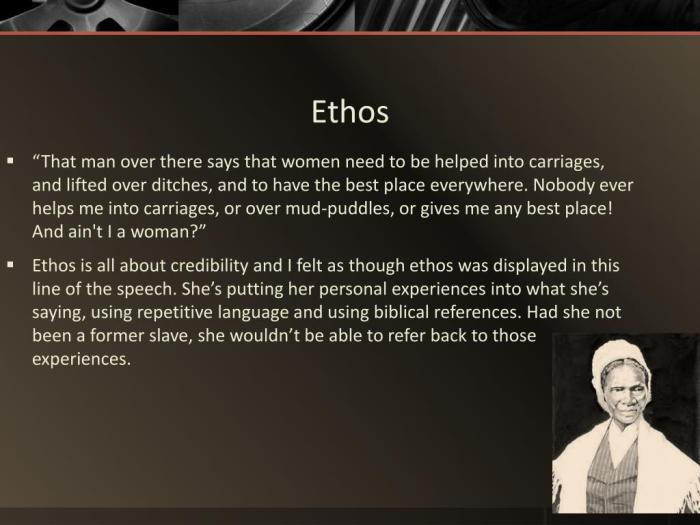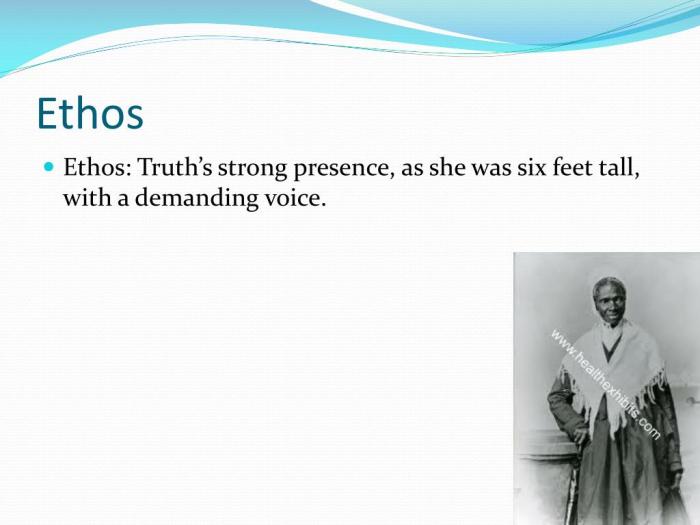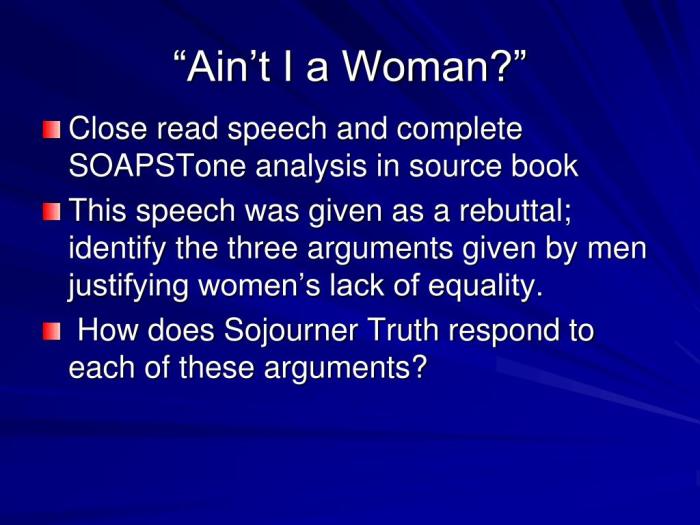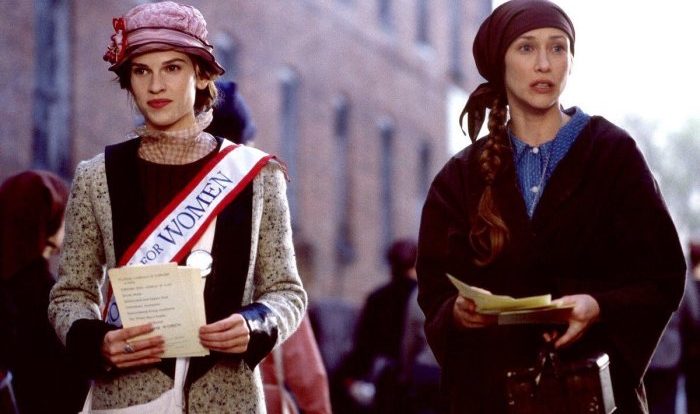Ethos in ain’t i a woman – In the annals of history, “Ain’t I a Woman,” Sojourner Truth’s iconic speech, stands as a testament to the power of ethos. This essay delves into the rhetorical strategies Truth employed to establish her credibility and persuasiveness, exploring the historical context that shaped her message and the impact it continues to have today.
Truth’s speech, delivered in 1851, was a bold challenge to the prevailing notions of gender and race. As a former slave and abolitionist, she drew upon her personal experiences and the shared struggles of women to build a compelling argument for equality.
Historical and Cultural Context of “Ain’t I a Woman”

Sojourner Truth’s speech “Ain’t I a Woman” emerged amidst the tumultuous social and political landscape of the 19th century United States. The abolitionist and women’s rights movements played pivotal roles in shaping Truth’s perspective and the context of her address.
Abolitionism and Sojourner Truth
As a former slave who escaped to freedom, Truth witnessed firsthand the horrors of slavery and its dehumanizing effects. She became a staunch abolitionist, advocating for the immediate end to slavery and the liberation of all enslaved people. Her experiences and unwavering commitment to abolitionism informed her understanding of the intersectionality of race and gender oppression.
Women’s Rights Movement and Sojourner Truth
The women’s rights movement gained momentum in the 19th century, demanding equal rights and opportunities for women. Truth aligned herself with this movement, recognizing that the fight for racial equality could not be separated from the fight for gender equality.
She argued that women deserved the same rights and freedoms as men, regardless of their race or gender.
Intersectionality of Race and Gender
Truth’s speech challenged the prevailing notion that women were inferior to men, particularly Black women. She highlighted the double oppression faced by Black women, who were subjected to both racial and gender discrimination. By asserting her own humanity and demanding equal treatment, Truth exposed the hypocrisy and injustice of the patriarchal and racist society of her time.
Rhetorical Devices and Ethos
Sojourner Truth employed a range of rhetorical devices to establish her ethos as a credible and persuasive speaker. These devices included personal anecdotes, biblical allusions, and appeals to logic.
Personal Anecdotes
Truth’s speech is peppered with personal anecdotes that illustrate her experiences as a slave and a woman. These anecdotes serve to connect her with her audience on a personal level and to make her arguments more relatable. For example, she recounts being whipped and beaten as a child, and she describes the pain of being separated from her children.
These anecdotes help to establish her credibility as someone who has firsthand knowledge of the injustices she is speaking out against.
Biblical Allusions
Truth also makes frequent use of biblical allusions in her speech. These allusions serve to connect her arguments with the moral authority of the Bible. For example, she compares herself to the biblical figure of Moses, who led the Israelites out of slavery.
She also invokes the image of the Last Judgment, when all people will be held accountable for their actions. These allusions help to give her speech a sense of urgency and to make her arguments more persuasive.
Appeals to Logic
In addition to personal anecdotes and biblical allusions, Truth also employs appeals to logic in her speech. She uses clear and concise language to explain her arguments, and she provides evidence to support her claims. For example, she points out that women are just as capable as men of performing physical labor, and she argues that they should therefore be given the same rights as men.
These appeals to logic help to make her speech more persuasive and to convince her audience of the validity of her arguments.
Overall, Truth’s use of rhetorical devices is highly effective in establishing her ethos as a credible and persuasive speaker. Her personal anecdotes, biblical allusions, and appeals to logic all serve to connect her with her audience, to give her speech a sense of urgency, and to make her arguments more persuasive.
Argument and Structure

Sojourner Truth’s speech, “Ain’t I a Woman?”, is a powerful and persuasive argument for the rights of women. Her main argument is that women are just as capable as men, and that they deserve the same rights and opportunities. She builds her case using a combination of logical reasoning and emotional appeals.
Truth begins her speech by establishing her credibility as a speaker. She points out that she has worked hard all her life, and that she has raised thirteen children. She also emphasizes her physical strength, noting that she has “plowed and planted, and gathered into barns.”
This establishes her as a capable and hardworking woman who is deserving of respect.
Truth then goes on to argue that women are just as capable as men. She points out that women can do all the same things that men can do, and that they are just as strong and intelligent. She also argues that women are entitled to the same rights and opportunities as men, including the right to vote.
Truth uses a variety of rhetorical devices to make her case more effective. She uses repetition to emphasize her main points, and she uses parallelism to create a sense of rhythm and flow. She also uses emotional appeals to connect with her audience.
For example, she tells the story of how she was whipped by a slave master, and she describes the pain and humiliation she endured. This helps to create a sense of empathy and understanding among her audience.
Truth’s speech is a powerful and persuasive argument for the rights of women. She uses a combination of logical reasoning and emotional appeals to make her case, and she effectively uses rhetorical devices to enhance her message.
Logical Reasoning
Truth uses a variety of logical arguments to support her claim that women are just as capable as men. She points out that women can do all the same things that men can do, and that they are just as strong and intelligent.
She also argues that women are entitled to the same rights and opportunities as men, including the right to vote.
One of the most effective logical arguments that Truth uses is her analogy between women and men. She argues that women are just as capable as men, and that they deserve the same rights and opportunities, because they are both human beings.
This analogy is effective because it is simple and straightforward, and it is difficult to argue against.
Truth also uses a variety of examples to support her arguments. She tells the story of how she was whipped by a slave master, and she describes the pain and humiliation she endured. She also talks about how she has worked hard all her life, and how she has raised thirteen children.
These examples help to make her arguments more concrete and believable.
In Sojourner Truth’s powerful speech “Ain’t I a Woman,” she effectively employs ethos, establishing her credibility and authority as a speaker. To further explore the nuances of synonyms and expand your vocabulary, consider visiting level f unit 3 synonyms . By understanding the various shades of meaning conveyed by different words, you can enhance your writing and speaking abilities.
Returning to Truth’s speech, her use of ethos enables her to connect with her audience and persuasively convey her message.
Emotional Appeals
In addition to logical arguments, Truth also uses a variety of emotional appeals to connect with her audience. She tells the story of how she was whipped by a slave master, and she describes the pain and humiliation she endured.
This helps to create a sense of empathy and understanding among her audience.
Truth also uses a variety of rhetorical devices to enhance her message. She uses repetition to emphasize her main points, and she uses parallelism to create a sense of rhythm and flow. These devices help to make her speech more memorable and impactful.
Effectiveness of Repetition and Parallelism
Truth’s use of repetition and parallelism is highly effective. Repetition helps to emphasize her main points, and it creates a sense of rhythm and flow that makes her speech more memorable. Parallelism also helps to create a sense of rhythm and flow, and it makes her arguments more clear and concise.
For example, Truth repeats the phrase “Ain’t I a woman?” throughout her speech. This repetition helps to emphasize her main point, which is that women are just as capable as men and that they deserve the same rights and opportunities.
Truth also uses parallelism to create a sense of rhythm and flow in her speech. For example, she says, “I have plowed, and planted, and gathered into barns, and no man could head me! And ain’t I a woman?” This parallelism helps to make her speech more memorable and impactful.
Overall, Truth’s use of repetition and parallelism is highly effective. These devices help to emphasize her main points, create a sense of rhythm and flow, and make her speech more memorable and impactful.
Symbolism and Imagery: Ethos In Ain’t I A Woman

Truth’s speech is replete with powerful symbols and vivid imagery that amplify the emotional impact of her message. She employs these literary devices to connect with her audience on a visceral level and evoke a profound sense of empathy and understanding.
Metaphors
Truth’s use of metaphors is particularly striking. She compares the oppression of women to being “tramped upon” and “crushed down.” These metaphors convey the immense weight of discrimination and injustice that women have endured. By likening women to objects that are trampled and crushed, Truth highlights the dehumanizing nature of their treatment.
Similes, Ethos in ain’t i a woman
Truth also employs similes to create vivid comparisons. She describes women as being “as strong as men” and “as capable as men.” These similes challenge the prevailing stereotypes of women as weak and incapable. By comparing women to men, Truth asserts their equality and undermines the justifications for their oppression.
Personification
Truth personifies abstract concepts to make them more tangible and relatable. She speaks of “Truth” as a living entity that is “crushed down” and “trodden upon.” By giving human qualities to Truth, Truth emphasizes its importance and the consequences of its suppression.These
symbols and images work together to create a powerful tapestry of oppression and resistance. They evoke a deep emotional response from the audience, stirring feelings of sympathy, anger, and determination. Through her skillful use of language, Truth not only argues for women’s rights but also paints a vivid and unforgettable portrait of the struggles and triumphs of her people.
Language and Style
Sojourner Truth’s speech is characterized by its powerful and authentic language. She employs a blend of colloquialisms, vernacular, and rhetorical questions that resonate with her audience and convey her message with undeniable force.
Colloquialisms and Vernacular
Truth’s use of colloquialisms and vernacular lends a conversational tone to her speech, making her message accessible and relatable. She employs phrases like “ain’t I a woman?” and “I have borne thirteen children” that are familiar to her audience and reflect the language of everyday speech.
This choice of language creates a sense of intimacy and immediacy, drawing the audience into her personal experience and making her arguments more persuasive.
Rhetorical Questions
Truth also employs rhetorical questions to emphasize her points and challenge her audience to confront the inconsistencies in their own beliefs. She asks, “If my cup won’t hold but a pint, and yours holds a quart, wouldn’t you be mean not to let me have my little half measure full?” These rhetorical questions force the audience to confront the absurdity of the arguments used to justify the oppression of women and to acknowledge the hypocrisy of those who claim to be advocates of equality.
Impact and Legacy

Sojourner Truth’s “Ain’t I a Woman?” speech had an immediate and profound impact on the women’s rights movement. It helped to galvanize the movement and inspired generations of activists.
Long-Term Impact
In the long term, Truth’s speech has continued to resonate in contemporary society. Her words have been used by activists to fight for the rights of women and other marginalized groups. They have also been used to inspire works of art, literature, and music.
For example, in 1977, the National Organization for Women (NOW) used Truth’s speech as the inspiration for its “Ain’t I a Woman?” campaign. The campaign was designed to raise awareness of the ongoing struggle for women’s rights. In 2015, the United States Postal Service issued a stamp commemorating Truth and her speech.
Sojourner Truth’s “Ain’t I a Woman?” speech is a powerful reminder of the importance of fighting for the rights of all people. Her words continue to inspire activists today and will likely continue to do so for generations to come.
FAQ Insights
What is the main argument of “Ain’t I a Woman”?
Truth argues that women, regardless of their race or gender, are entitled to the same rights and respect as men.
How does Truth establish her ethos?
She draws on her personal experiences, biblical allusions, and appeals to logic to build her credibility and persuasiveness.
What is the significance of Truth’s use of repetition and parallelism?
These rhetorical devices emphasize her key points and create a sense of urgency and emotional impact.
